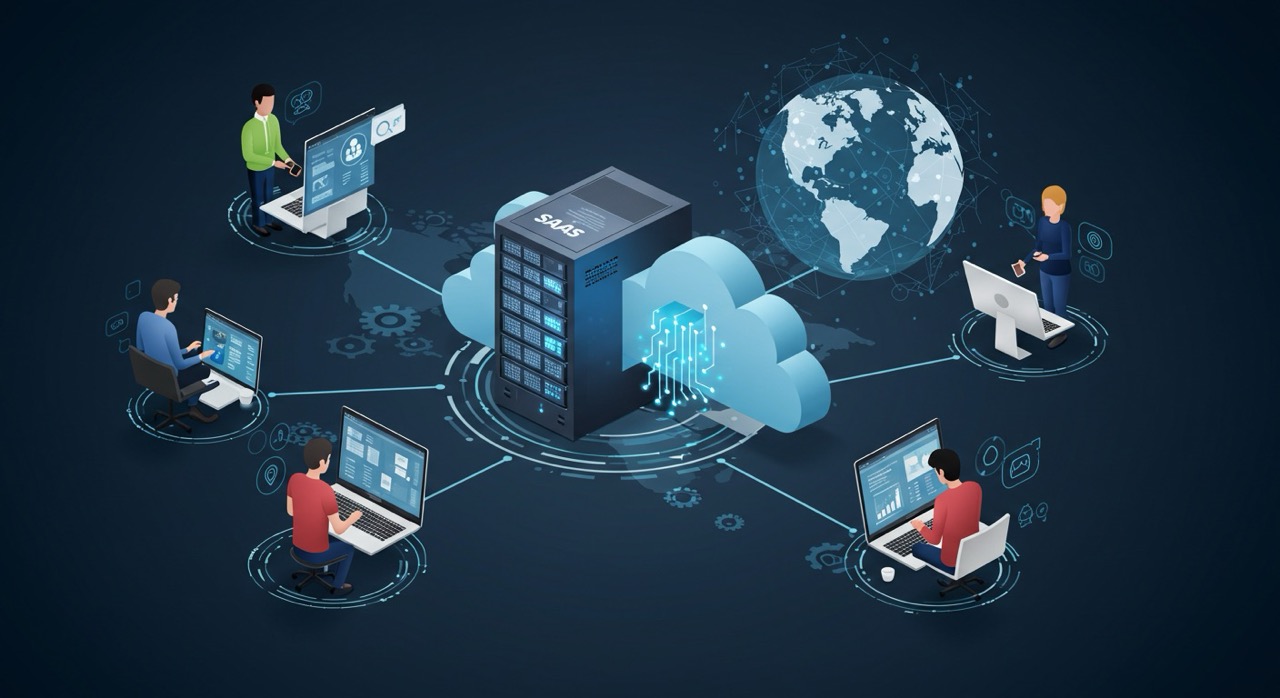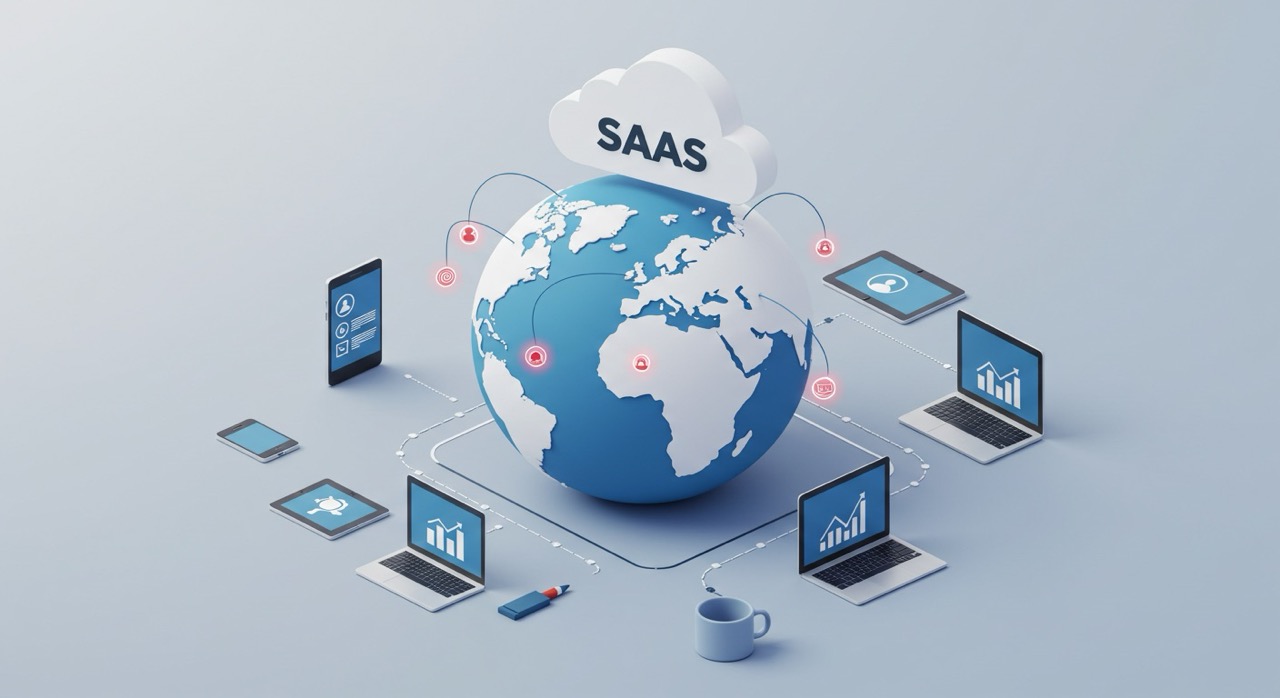Did you know that the global SaaS market is projected to reach a staggering $744.44 billion by 2028? This incredible growth reveals how SaaS impacts businesses of all sizes. SaaS has become a prevalent model for delivering cloud software applications. Agile organisations use it to streamline operations, reduce costs, and boost productivity.
We’ve written this post to clarify what SaaS is, how it works, and its key characteristics and benefits. Plus, the exciting trends that will shape its future in 2025 and beyond.
- What is SaaS? What Does SaaS Stand For?
- Key Characteristics of SaaS
- SaaS Pricing Models
- SaaS vs. On-Premise
- Benefits of SaaS for Small Businesses
- Challenges and Risks
- Top 10 SaaS Trends to Watch in 2025
- Common SaaS FAQs
- Difference between SaaS, IaaS, and Paas
Today’s Focus of Attention is reader-supported. We sometimes include products we think are useful for our readers. If you buy through links on this page, we may earn a small commission.
What is SaaS? What Does SaaS Stand For?

SaaS, or Software as a Service, is an approach to software delivery in which users subscribe to applications rather than purchasing or installing them on their computers. Instead, a third-party provider hosts and manages the software.
To gain access, users simply log in through a web browser or a dedicated app.
Since SaaS solutions are subscription-based, you pay a recurring fee to connect to the software. They’re common nowadays, from 3D animation and accountancy to communication and email. Think of SaaS as streaming music on Spotify; no downloads, no physical albums—just instant access. It saves companies from investing in expensive infrastructure.
Key Characteristics of SaaS
Cloud-Based
SaaS applications live in the cloud, allowing clients to access them from anywhere on any device with an internet connection.
Multi-Tenant Architecture
A single instance of a SaaS application serves multiple customers. Each customer’s data is securely segregated.
Automatic Updates
SaaS providers handle all software updates and maintenance. Meaning, you always have the latest features and security patches.
On-Demand Scalability
You can scale your SaaS usage up or down to accommodate changing business needs without hardware upgrades.
Examples of SaaS Applications
| Customer Relationship Management (CRM) | Salesforce, HubSpot |
| Enterprise Resource Planning (ERP) | Oracle NetSuite, SAP S/4HANA Cloud |
| Email Marketing Platforms | Mailchimp, Constant Contact |
| Project Management (PM) Tools | Asana, Trello |
| Accounting | Xero, QuickBooks |
| Communication and Collaboration | Slack, Microsoft Teams |
| Creativity | Adobe Creative Cloud (Photoshop, Premiere, Illustrator) |
SaaS Pricing Models
In general, companies find using a SaaS product more budget-friendly than buying and installing a traditional software license. Based on this, providers offer different options to cater those organisations, resulting in the following plans:
Free or Ad-Based: The provider generates revenue by displaying advertisements and there’s often an option to upgrade to a paid tier with no ads.
Flat Rate: For a fixed monthly or annual fee, users have access to all the software’s features.
Per User: This model depends on how many people will be using the service.
Storage Tiers: Customers can access the app freely, but once they exceed the free limit, they must pay for additional space.
Pay As You Go: The more you use the service, the more you pay.
Feature-Based Tiers: Basic versions of the software with limited features have a lower price, while tiers with more features come at a higher fee.
Freemium: The application is free to use at an entry-level tier. However, there are some restrictions on advanced functionalities.
SaaS vs. On-Premise: A Detailed Comparison

Now, with the key characteristics of SaaS identified, let’s compare SaaS solutions with traditional on-premise software.
This summarising chart highlights the major differences between the two systems:
SaaS vs On-Premise
| Feature | SaaS | On-Premise | Examples |
|---|---|---|---|
| Deployment | Cloud-based | Installed on local servers | SaaS: Salesforce, Google Workspace; On-Premise: Microsoft Exchange Server, SAP ERP |
| Cost | Subscription-based | Upfront investment and ongoing maintenance costs | SaaS: Monthly or annual subscription fees; On-Premise: Server hardware, software licenses, IT staff |
| Scalability | Highly scalable | Less scalable, requires hardware upgrades | SaaS: Easily add or remove users and features; On-Premise: Requires purchasing and installing additional hardware |
| Accessibility | Accessible from anywhere with internet connection (with potential limitations) | Limited to devices within the local network | SaaS: Access via web browser or app; On-Premise: Access through company network |
| Security | Managed by the SaaS provider | Responsibility of the business | SaaS: Provider implements security measures; On-Premise: Business manages its own security infrastructure |
| Maintenance | Handled by the SaaS provider | Requires dedicated IT staff | SaaS: Automatic updates and maintenance; On-Premise: Manual updates and troubleshooting |
| Flexibility | Can be less flexible for extensive customization but offers integration options | Highly customizable but integration can be complex | SaaS: Integration with other SaaS applications and APIs; On-Premise: Customization to specific business processes |
| Control | Less control over data and infrastructure | Full control over data and infrastructure | SaaS: Data stored on provider’s servers; On-Premise: Data stored on company’s own servers |
Choosing the Right Solution
Deciding between SaaS and on-premise depends on your business needs and priorities. Here’s a framework to help you make an informed decision.
Budget: How much can you spend on an online platform?
How much would it cost to install your own servers?
Industry Requirements: Consider your specific demands for data control, security, and compliance.
Scalability: Assess your growth plans before investing in any digital tool.
Customisation: Is it necessary to tailor an application to meet your business processes?
IT Resources: Do you have the expertise to manage on-premise solutions?
How much does it cost to keep a dedicated IT staff?
Benefits of SaaS for Small Businesses & Startups
Picture your firm competing with industry giants. SaaS offers advantages that were previously unavailable or too expensive with traditional software:
Cost Savings
No upfront investments in hardware or licences.
No ongoing maintenance or IT support costs.
Increased Accessibility: With an internet connection, users can access SaaS from anywhere. This is favourable for organisations with remote work and collaboration.
Scalability and Flexibility: A business may scale up or down a service to meet changing needs. Also, this allows companies to avoid overspending on unnecessary resources
Enhanced Security: Established SaaS providers commit extensive funding to protect their customers’ data. It helps businesses with limited funds to set up strong protection on their own.
Competitive Advantage
Advanced functionalities allow small organisations to compete with larger enterprises.
Practical Examples
- A retail business uses Shopify (a SaaS-based point-of-sale system) to handle inventory and transactions and to track sales data without investing in expensive hardware.
- A startup implements Salesforce for customer interactions, tracking leads, and automated marketing strategies. It results in improved engagement and higher revenues.
- An agency runs Asana to collaborate with clients, remain on schedule, and manage deadlines.
- To automate email campaigns, a growing e-commerce business uses Mailchimp. This SaaS-based platform also segments customers and tracks performance.
- In manufacturing, NetSuite (ERP system) manages inventory, monitors production, and streamlines operations, improving efficiency and reducing costs.
Potential Challenges & Risks of SaaS
While SaaS offers many advantages, you should be aware of its considerable drawbacks.
| Vendor Lock-In | Switching to a different software could be difficult if needed. |
| Security Risks | Relying on a third party to store and manage your data carries a certain level of risk. |
| Integration Issues | Merging new solutions with existing systems may lead to negative outcomes. |
| Internet Dependency | Software as a Service relies on a stable internet connection. So, a disruption in connectivity might affect access to any application. |
Of these points, number four is the most critical. What would happen if a natural disaster disrupted the internet service?
Top 10 SaaS Trends to Watch in 2025
The SaaS ecosystem is evolving. With new functions emerging to shape the future of software delivery, here is a list of 10 capabilities to keep an eye on this year.
AI and Automation
Integrated Artificial Intelligence systems automate tasks, personalise experiences, and improve efficiency. AI-powered chatbots simplify support interactions. While AI-driven analytics tools provide valuable insights into business performance.
Vertical SaaS
With specialised functionalities, SaaS services tailored to specific industries are gaining traction. For instance, vertical SaaS solutions for the healthcare industry offer HIPAA (Health Insurance Portability and Accountability Act of 1996) compliance and electronic health record (EHR) integration.
Cybersecurity
Rising cyber threats prompt SaaS providers to prioritise security to protect customer data. This includes implementing robust protocols, encryption, and regular vulnerability audits.
Low-Code and No-Code Platforms
They enable businesses to customise applications with minimal or no coding knowledge. This empowers organisations to create solutions for their particular needs.
Micro SaaS
Small, niche SaaS products cater to a specific market with specialised functionalities.
Usage-Based Pricing
SaaS pricing models allow organisations to pay only for the resources they consume.
Seamless Integrations
They open the door to connect different apps and streamline workflows.
Mobile-First
Applications are designed with mobiles in mind. This shows a rise in portable device use for work, demanding constant access.
White Labelling
This feature authorises businesses to rebrand and personalise software. In this mode, organisations can offer solutions under their own brand.
Customer-Centric Design
SaaS solutions prioritise user experience and testimonials to improve usability and satisfaction. This includes:
- Designing intuitive interfaces.
- Providing comprehensive support.
- Incorporating user feedback into product development.
Common SaaS FAQs

Can SaaS Be On-Premise?
At its core, Software as a Service is a cloud-based software delivery model. An external provider hosts the applications, which users access through the internet.
In contrast, on-premise means installing software onto a company’s local servers. Thus, the organisation keeps full control over every aspect, including:
- Hardware
- Software
- Server maintenance
- Updates, security, and data backups
Considering these fundamental definitions, the concept of “on-premise SaaS” presents a contradiction.
However, there is “hybrid SaaS”. It describes a model that blends elements of both on-premise and cloud-based infrastructure. In this setup, certain components are on the client’s local servers, while others remain in the cloud.
Some businesses might go for ‘hybrids’ to achieve greater customisation and control. Or to address issues related to internet connectivity or latency in specific regions, or to follow regulatory and data sovereignty requirements.
SaaS Expenses: Opex or Capex?
Companies classify spending on SaaS as Opex. Why?
- They get it through a subscription-based model, paying every month or year.
- The usage of SaaS is often tied to shorter contract terms. The benefits from the service are generally realised within the current fiscal year.
- The subscribing company does not own the software itself. It is hosted and controlled by an external provider.
Nevertheless, a few exceptions may apply. Costs related to configuring and customising SaaS solutions can be counted as Capex. This might happen if the customer controls the intellectual property of the customised software. Also, if the client develops bridging modules for integrating SaaS with existing on-premise systems or the creation of bespoke extra capabilities.
Data Ownership in SaaS
Customers own the data they create, upload, or process using the SaaS platform. Standard contracts state this. But they grant the SaaS provider access and use of this database for specific reasons, such as:
- Providing the agreed-upon services.
- Improving the platform’s functionality.
- Generating aggregated, anonymised files for analytical purposes.
In the contract, it is vital to outline explicitly what the vendor can and cannot do with the customer’s data.
Difference Between SaaS, IaaS, and PaaS
SaaS (Software as a Service) provides applications that users access via the internet, through a web browser or a dedicated mobile app. It’s like renting a furnished apartment—you move in and use what’s provided. Examples include:
- Email (Gmail)
- CRM systems (Salesforce)
- Office productivity suites (Microsoft 365, Google Workspace)
- Collaboration tools (Slack)
- File storage (Dropbox)
IaaS (Infrastructure as a Service) rents virtual computing resources and storage space, including:
- Servers
- Hard and Solid-State Drives
- Networking
- Virtualisation
With IaaS, the user controls the operating systems, middleware, applications, and data. While the cloud provider manages the physical infrastructure. Imagine renting an empty lot and building your own house. You handle the design and maintenance, but the land is provided.
Examples of IaaS include:
- Amazon Web Services (AWS)
- Google Compute Engine
- Microsoft Azure Virtual Machines
PaaS (Platform as a Service) allows developers to build, run, and manage applications. They don’t have to deal with the underlying infrastructure. PaaS has all the tools and libraries.
It is similar to renting a workshop with equipment. You bring your materials and create what you want.
Examples of PaaS include:
- AWS Elastic Beanstalk
- Google App Engine
- Microsoft Azure App Services
In a nutshell:
- SaaS is for simplicity.
- IaaS for maximum control.
- PaaS for development.
Each model caters to different needs and levels of technical expertise. Look at this chart for a more visual grasp:
SaaS vs IaaS vs PaaS
| Feature | SaaS (Software as a Service) | IaaS (Infrastructure as a Service) | PaaS (Platform as a Service) |
|---|---|---|---|
| What it is | Ready-to-use software applications accessed over the internet | On-demand access to fundamental IT infrastructure (servers, storage, etc.) | Platform for developing, running, and managing applications |
| User Management | Primarily manages data and user access within the application | Manages operating systems, middleware, applications, and data | Manages applications and data |
| Provider Management | Manages all aspects: infrastructure, platform, and application | Manages infrastructure (servers, storage, networking, virtualization) | Manages infrastructure, operating systems, and development tools |
| Control Level | Lowest level of control; primarily uses the application | Highest level of control over infrastructure | Mid-level control; focuses on application development and deployment |
| Scalability | Highly scalable; adjust subscription levels as needed | Highly scalable; can scale infrastructure resources up or down | Highly scalable; platform scales to application needs |
| Technical Expertise | Minimal technical expertise required; ideal for end-users | Requires significant IT expertise to manage infrastructure | Requires development skills to build and deploy applications |
| Examples | Salesforce, Gmail, Microsoft 365, Dropbox, Slack | AWS EC2, Google Compute Engine, Azure Virtual Machines | AWS Elastic Beanstalk, Google App Engine, Azure App Services, Heroku |
| Primary Users | End-users, business users | IT administrators, network architects | Developers, IT operations teams |
SaaS has become an integral tool for businesses of all sizes, offering a wide range of benefits while driving efficiency and growth. By understanding its impact on organisations, entrepreneurs and business leaders can make informed decisions about leveraging solutions to achieve their financial goals.
Thus, to remain competitive and unlock additional levels of agility, stay abreast of the latest innovations in your industry.
If you find this post useful, please share it with your entrepreneur friends. Likewise, if you want us to publish any related topic, feel free to reach out with your request.



2 thoughts on “Is SaaS Right for Your Business? A Complete Guide for Startups and SMEs in 2025”